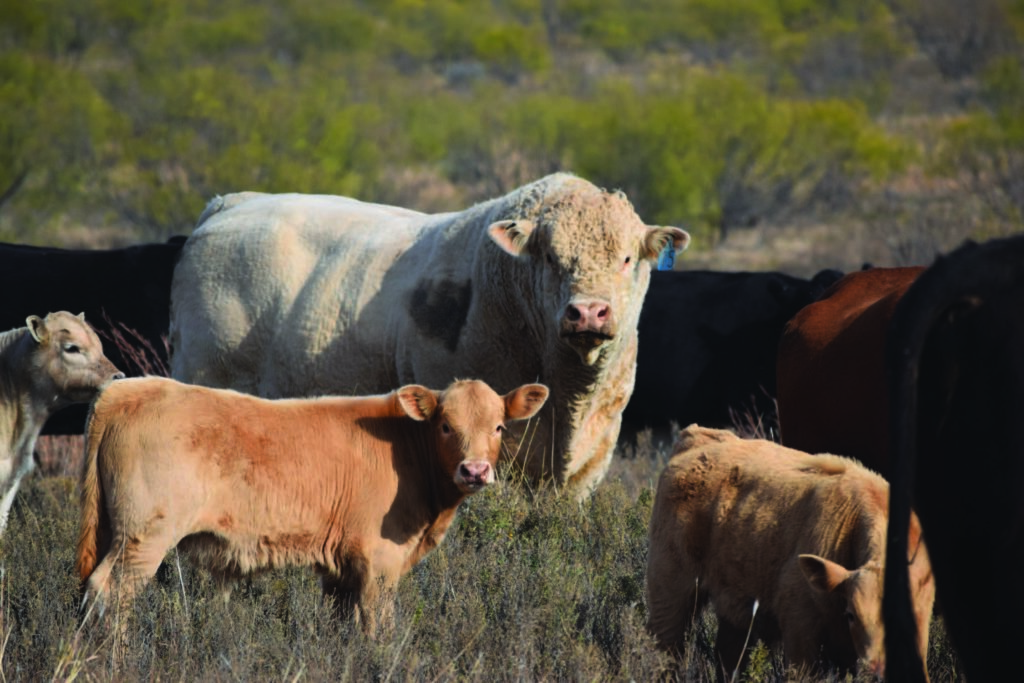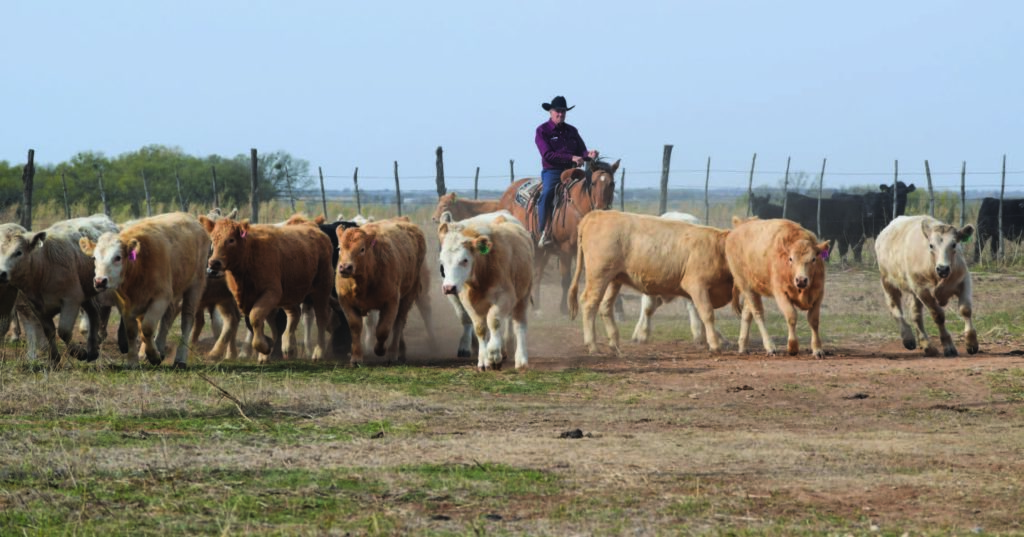Texas rancher has achieved the pounds he wants from his Charolais bulls. Now, he is looking to add marbling.
By Paige Nelson
There are commercial cattlemen who do as little record keeping as possible. I know of one ranch that doesn’t tag the calves, “because it takes away from profit.” Then, there’s Max Martin, owner of JX Ranch in Loving, Texas.
Martin is a firm believer that to be a beef producer, “you’ve got to know your product.” He raises only terminal calves, so in order to know his product he studies his bulls.
JX Ranch
Martin has been using Charolais bulls on an Angus, black baldie, Red Angus and red baldie cow herd for nearly 20 years. He calves both spring and fall and will keep his calves as stockers before sending them to the feedlot. Martin has developed a relationship with two feedlots, the stronger of which is CRI Feeders in Guymon, Okla. Depending on the year and market, Martin will retain full or partial ownership or sell the calves to the feedlot.
A reliable relationship with the feedlot is important to Martin. He wants to know his calves are headed to a place that will push them to reach the genetic potential he has so carefully bred into them.
Yet, while genetics are everything, they are nothing in the absence of good management. JX Ranch uses a stringent immunization protocol.
“We try to really be students of disease prevention,” says Martin.
“What we try to do is have a tremendous immunization program, and we just try to have best practices around it. For example, when we handle our cattle, we use the same cowboys all the time. Everybody knows that we want good handling practices. We want good med practices right down to needle usage, right down to keeping refrigeration on the meds, just all those fundamental things.”

He primarily buys bulls from Derry Wright, owner of Wright Charolais in Richmond, Mo.
“I like Derry. He stands behind his product, he’s a very EPD savvy guy, and he’s trying to bring those EPDs up on marbling, and he knows what I’m looking for,” says Martin.
Because Martin maintains both a spring and fall calving herd, both herds operating under a strict 60-day breeding season, he uses his bulls four months out of the year.
“My economics say I buy more expensive bulls,” explains Martin, “but I use them twice a year, which basically says even though I’m buying a more expensive bull, my bull cost is half of what the normal rancher is paying.”
Distance is not an issue when it comes to buying bulls out of state for Martin.
“I don’t buy ‘good guy’ bulls. I buy high EPD bulls. I want to go to a sale where there’s a lot of choice.”
Numbers Game
To Martin, “a lot of choice” means a sale offering of several bulls in the top 30% of the breed for yearling weight, ribeye area and marbling, without sacrificing calving ease, with American-International Charolais Association (AICA) terminal sire index (TSI) scores of at least 205 or higher.
Martin knows exactly what he wants in his bulls because he knows what kind of beef product he wants on the rail. He knows what his current beef product is because he tracks it all the way from sire to processor.
Martin keeps a working record of his entire bull battery. It includes each bull’s registration number and corresponding AICA percentile rankings for yearling weight, ribeye area and marbling. Also listed are the bulls’ EPD values for calving ease and yearling weight, birth date, and TSI score. This document also contains a listing of the cow herd’s nutrition and protein supplementation schedule, immunization program, calf preconditioning program, stocker program and calf performance history including average daily gain in the feedlot and carcass data.
Every time Martin sends a truckload of calves to the feedlot, he also sends this document to the feedlot manager.
“I publish all of my bull data, so they know the EPDs of the bull, and of course, they have the calves on the ground. They watch them from a health point of view, and they watch them from a gain point of view. Then, they know the U.S. Premium Beef grid, and that basically says ‘Hey, here’s a guy that has a good solid disease prevention program and here’s a guy that knows bulls and knows the EPDs of the bulls and how to put a bull on the ground that will produce a calf that will gain and produce on the grid,'” says Martin.
Besides recording all known data about his cattle, Martin dips a toe into the seedstock pond by parentage testing his calves. He wants to know which bulls are working the best, and he wants to see his EPDs work economically.
“I am proving my bull herd over time,” he says. “Every time I need to replenish my bull battery, I’m buying better bulls.”
 In the beginning, Martin admits he was just selling a hoofed animal. But about 10 years ago, he decided to try to take advantage of some of the quality premiums available, so he began using a multiple EPD sire selection criterion.
In the beginning, Martin admits he was just selling a hoofed animal. But about 10 years ago, he decided to try to take advantage of some of the quality premiums available, so he began using a multiple EPD sire selection criterion.
“I used to buy 190 TSIs, then I bought 200s. Now I’m buying 205s, 208s and trying to get that terminal sire index up into the 208, 210 area. Of course I’m a commercial guy, so I’ve got to see this stuff be economically viable,” he clarifies.
Adding Marbling
“Pounds sell, but quality pounds sell better,” states Martin. During his evolution from a producer of commodity beef only, to a premium beef supplier, Martin recognized he had met his quantity goals. Now, he seeks for quality pounds.
“Most of the market is pounds, so naturally I wanted to start on the quantity side,” he says. “Charolais has a tremendous ability to put beef on the ground—their tremendous poundage from weaning on up. They’ve got great gains. Unfortunately, I don’t have the quality that I want, so now I’m trying to put a better quality calf out there, which basically says marbling.”
Martin knows he doesn’t have the marbling he needs because he knows his numbers. From April to May of 2017, 67 percent of the calves CRI fed graded Choice or higher. But only 22 percent of Martin’s calves graded that high. Numbers like that just fuel Martin’s fire.
“That shows you,” says Martin, “I don’t have the marbling that I needed back then to get those good-graded carcasses. But on the other hand, I have a lot of pounds. I have a big steer. I’m trying to balance that with more marbling.”
By using EPDs, parentage testing and carcass data, Martin is running a privately-funded scientific study on the usefulness of EPDs in a commercial environment with real money on the line.
“Mainly what I’ve done is I have proven that EPDs work in a commercial environment,” he states. “I can tell you that 70-80 percent of my calves follow the EPD of that bull.”
Because Martin has the data behind, in front and around him, he holds everyone in the production chain accountable, especially the seedstock industry.
“I’ve got these higher end marbling bulls, and they better produce that higher end marbling calf or I’m going to go back and say, ‘Hey Charolais folks, I don’t believe your EPD data. It doesn’t pan out in a commercial environment.'” However, Martin admits he has proven the gain EPDs from the Charolais seedstock industry and this year weaned calves weighing 690 pounds.
Martin says he will not compromise a sturdy, strong bull for high quality beef. He wants both.
 He describes his range as “rough territory.” He grazes cattle on 13,000 acres of steep hills, rocks and canyons, and hot weather. “I need a really durable bull,” he says. But to the Charolais breed’s credit, Martin has a 7-year-old bull still on his place.
He describes his range as “rough territory.” He grazes cattle on 13,000 acres of steep hills, rocks and canyons, and hot weather. “I need a really durable bull,” he says. But to the Charolais breed’s credit, Martin has a 7-year-old bull still on his place.
Female Factor
Martin isn’t naive. He knows his cows play a role in his marbling conundrum. However, his credence in knowing his numbers has shown he must be careful in his heifer selection. Martin openly admits his replacement heifer selection program is failing. As nice as quality beef premiums are, it’s a delicate economic balance to buy replacement heifers with known EPDs.
When recently shopping for heifers, Martin tells, “I found three sets of heifers. I loved them. I loved their EPDs. They were good looking heifers, and I bid on them. I couldn’t buy them. They went for $2,350. I came back to Texas, and I bought two truckloads of heifers delivered to the ranch for $1,575, so you look at that, that’s a $775 delta. You’re giving away all and more of your grading profit.”
The problem is Martin knows nothing about his new heifers from a genetic standpoint.
Martin says he prefers an F1 cross black baldie heifer, but he operates on economics not preference.
“I found plenty of heifers for $1,800-$1,850 that are black baldies that I like, but I like an Angus heifer at $1,575 better than an F1 at $1,850.”
For now, he will rely on his Charolais bulls to accelerate the marbling potential in his terminal calves and you can bet he will continue to keep a record of all progress.

